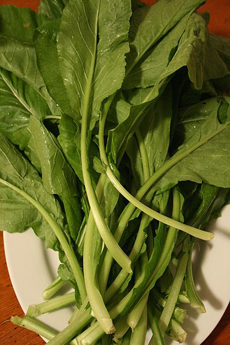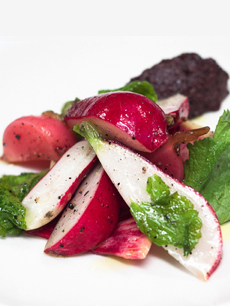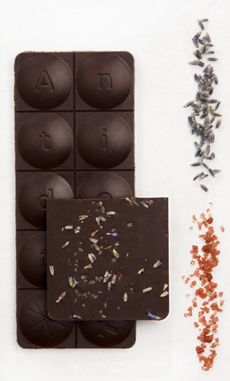|
Nutrition experts want you to eat more cruciferous vegetables: two to three times per week, with a serving size of at least 1-1/2 cups. If you eat two cups daily, so much the better. The vegetables are not only healthy, but they’re also very filling and low in calories.
The cruciferous group includes arugula, bok choy, broccoli, Brussels sprouts, cauliflower, cabbage, collard greens, cress, horseradish, kale, kohlrabi, mizuna, radish, rapini (broccoli rabe), rutabaga, tatsoi, turnip and wasabi, a type of horseradish. Mizuna (a variety of mustard green) and tatsoi have become “designer greens” in salads at America’s finest restaurants.
Pungent and peppery, mustard greens present a lighter form of the flavor of prepared mustard (which is made from the seeds of the plant). If you like mustard and haven’t yet had mustard greens, you’re in for a delightful surprise.
Mustard greens, like all vegetables, are cultivated in different varieties. The supermarket variety is emerald green in color, but specialty varieties can be found in farmers markets in shades of dark red and deep purple.
|
|

Raw mustard greens. Photo by Badagnani |
Wikimedia. |
|
Depending on the variety, the leaves can be rumpled or flat, with frilled, lacy or scalloped edges. You can store the fresh leaves in the fridge for four or five days. Wrap them in a paper towel and seal them in a plastic bag from which you’ve pressed out the air.
How To Cook Mustard Greens
Sautéed mustard greens. A quick sauté with garlic is easy to prepare. In a skillet, heat 5 tablespoons of olive oil (diet version: substitute broth, indulgent version: use bacon fat). When bubbles begin to form, add mustard greens and optional sliced onions and thinly sliced garlic. Cover and sauté for 5 minutes. Add a splash of balsamic vinegar or sesame oil to finish. Toss with a lemon vinaigrette: 3 tablespoons of extra virgin olive oil, 1 tablespoon lemon juice, 1 medium clove pressed garlic and salt and pepper to taste. Top with toasted walnut halves, croutons, crumbled bacon or other favorites.
Salads. Add raw to green salads, and raw or cooked to pasta salads.
Pizza. Make a pizza with cooked mustard greens, tomatoes, pine nuts or walnuts and crumbled goat cheese.
Stir frys.
You’ll find many other recipes, and can have fun creating your own.
Health Benefits Of Mustard Greens
Cruciferous veggies are rich in calcium, fiber, vitamins A, C, B6 and folic acid. They offer an impressive list of health benefits:
Cruciferous vegetables have been shown to help reduce free radicals in the body, which may help prevent cancer.
Studies suggest that B vitamins can help prevent cardiovascular disease and memory loss.
Since folate helps with the production of serotonin, it may be a mood booster.
The fiber helps with weight loss and maintenance (it keeps you feeling full and helps control hunger), can lower cholesterol and blood pressure and helps to counter high blood sugar by slowing the absorption of carbohydrates into the bloodstream after meals.
Mustard Greens Trivia
The cruciferous group takes its name from cruciferae, New Latin for “cross-bearing.” The four-petal flowers in this group grow in the shape of the cross.
Mustard greens originated in the Himalaya region of India, and have been cultivated for more than 5,000 years. Reminiscent of some Western African greens, mustard greens, along with turnip greens, became prominent in the cuisine of the American South in antebellum times.
Find more of our favorite vegetables and recipes in our Vegetables Section.
|
|







